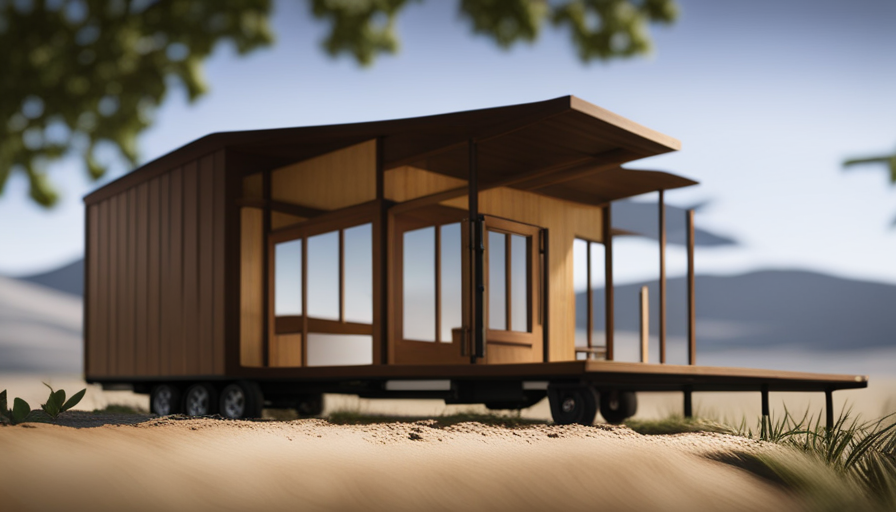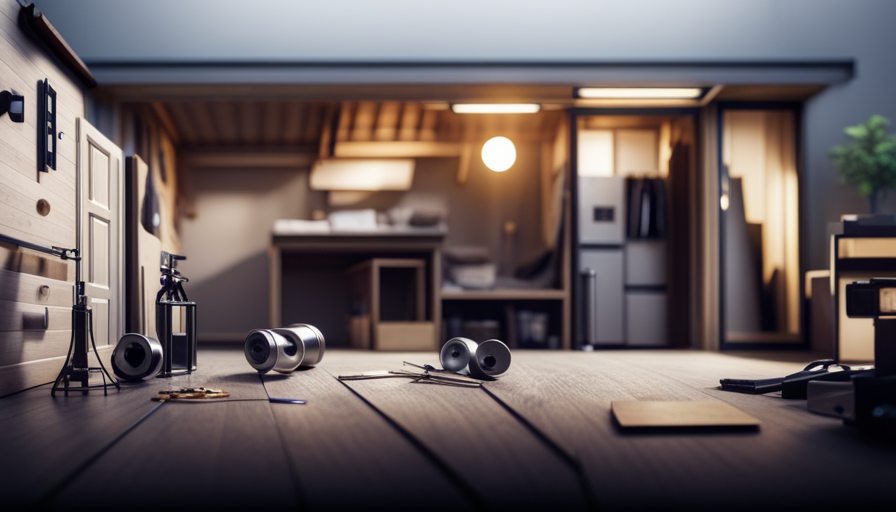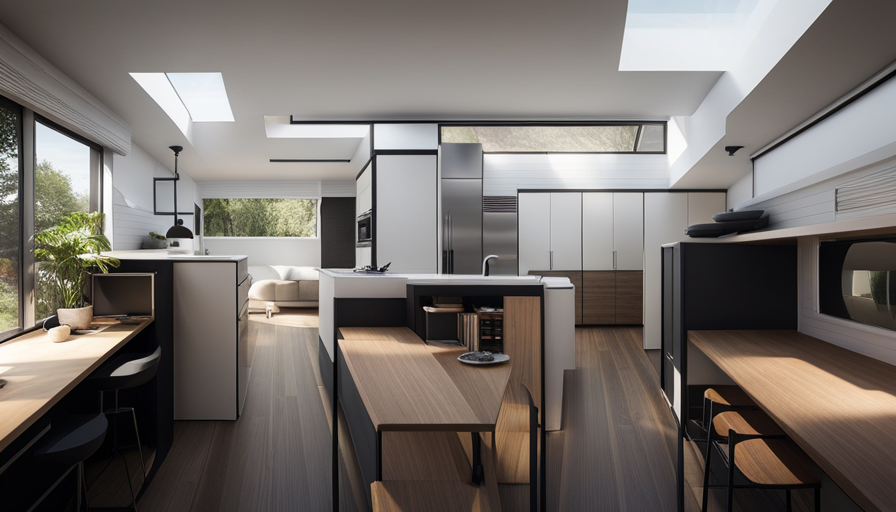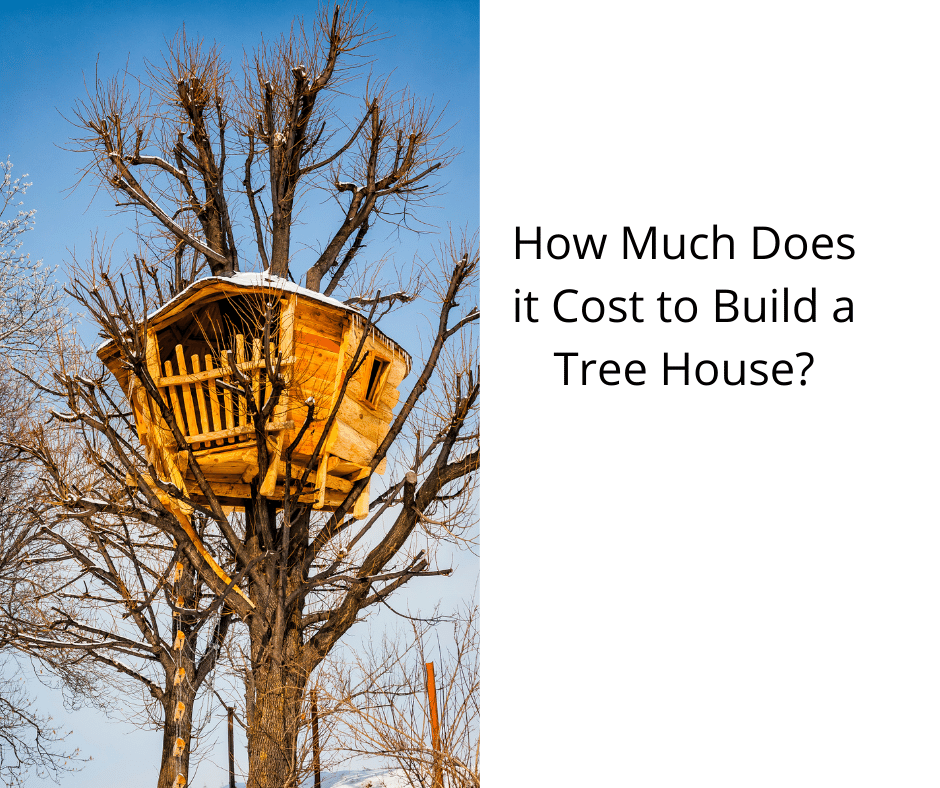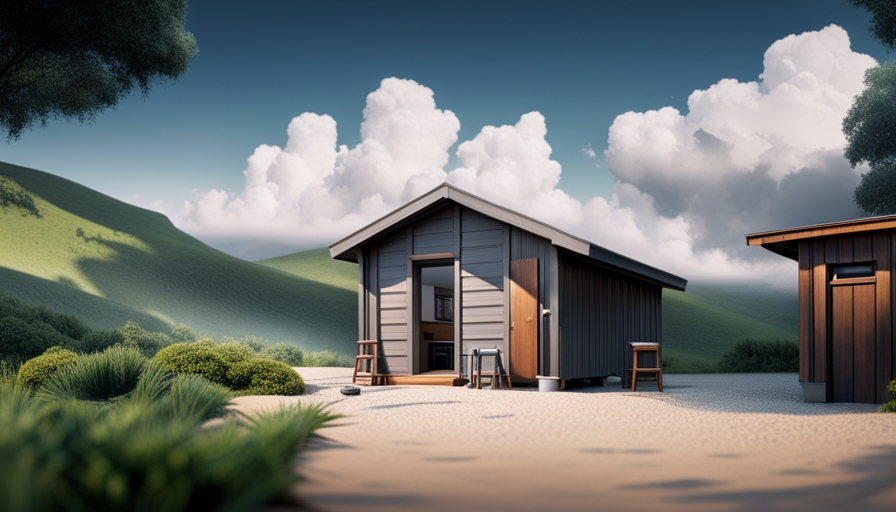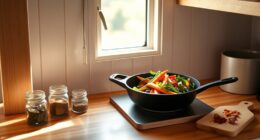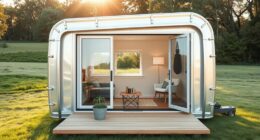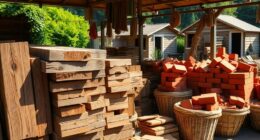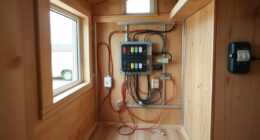Ever thought about the incredible strength and durability of custom-built tiny house trailers on wheels? Let me tell you, the incorporation of angle iron along the edges of these trailers is truly groundbreaking! When it comes to supplying structural support, angle iron plays a crucial role that is frequently overlooked. Not only does it offer stability, but it also greatly enhances the lifespan of these remarkable homes.
But here’s the real kicker – the size of angle iron used on the edges of these trailers is nothing short of awe-inspiring! It’s like a mighty fortress guarding the very foundation of your tiny house on wheels. From common sizes to expert recommendations, I’ll delve into every detail you need to know about selecting and installing the perfect angle iron for your tiny house trailer.
So, if you’re ready to unlock the secrets behind the strength and resilience of custom-made tiny house on wheels trailers, let’s dive into the world of angle iron and discover how it transforms these homes into engineering marvels.
Key Takeaways
- The size of angle iron chosen for custom-made tiny house trailers depends on the weight and specific load requirements of the house.
- Larger angle iron sizes offer greater support but add weight to the trailer, while smaller sizes may be more suitable for lighter loads and reduce overall weight.
- The thickness of the angle iron should be determined by the weight of the house and intended use of the trailer.
- Proper installation techniques, such as welding and bolting, are necessary for a secure connection between the angle iron and trailer frame.
Understanding the Purpose of Angle Iron in Tiny House Trailers
Do you ever wonder why angle iron is used on the edge of custom-made tiny house trailers? The purpose of angle iron in these trailers is to provide structural support and reinforcement.
When choosing angle iron for construction, it’s important to consider factors such as the weight and size of the tiny house, as well as the specific load requirements. Angle iron offers several advantages in construction. Firstly, it’s a strong and durable material that can withstand heavy loads and provide stability to the trailer. Its L-shape design allows for easy attachment to the trailer frame, ensuring a secure and reliable connection. Additionally, angle iron is versatile and can be easily welded or bolted together, making it a popular choice among builders.
By using angle iron on the edge of custom-made tiny house trailers, builders can ensure that the structure is strong and stable, creating a solid foundation for the tiny house. This provides peace of mind for the homeowners, knowing that their tiny house is built with quality materials.
Moving onto the next section about common sizes of angle iron used in tiny house trailer construction…
Common Sizes of Angle Iron Used in Tiny House Trailer Construction
Commonly used sizes of angle iron in the construction of tiny house trailer frames include various dimensions such as 2×2, 2×3, and 3×3. These sizes are chosen based on the specific needs of the trailer and the weight it will be carrying.
The angle iron provides structural support to the trailer, ensuring stability and durability during transportation. Choosing the right size angle iron is crucial to the overall strength and integrity of the trailer. A larger size, such as 3×3, offers greater support and can handle heavier loads, but it also adds weight to the trailer, which may impact its mobility.
On the other hand, a smaller size like 2×2 or 2×3 may be more suitable for lighter loads and can help reduce the overall weight of the trailer. When selecting the angle iron size, it is important to consider the specific requirements of your tiny house and how it will be used. Factors such as the weight of the house, the materials used in its construction, and the intended use of the trailer should all be taken into account.
By carefully choosing the right size angle iron, you can ensure that your tiny house trailer provides the necessary structural support for stability and durability. Transitioning to the next section, it is essential to understand the importance of choosing the right size angle iron for stability and durability without compromising mobility.
Importance of Choosing the Right Size Angle Iron for Stability and Durability
Selecting the perfect size of angle iron is crucial in ensuring your tiny home-on-wheels remains stable and durable, while still allowing for easy mobility. When it comes to choosing the right angle iron size for your tiny house trailer, durability and stability should be at the forefront of your decision-making process.
The angle iron that is used on the edges of the trailer plays a vital role in providing structural support and preventing any potential bending or warping.
To achieve the desired level of stability and durability, it is important to consider the weight and size of your tiny house. Larger tiny houses may require thicker and stronger angle iron to ensure adequate support. Additionally, the thickness of the angle iron should also be determined by the intended use of the trailer. If you plan on frequently traveling on rough terrains or encountering harsh weather conditions, opting for a thicker angle iron would be prudent.
Choosing the right size angle iron is crucial for the stability and durability of your tiny house on wheels. By selecting the appropriate thickness and size, you can ensure that your tiny home remains strong and secure while on the move.
In the next section, we will delve into the various factors you should consider when selecting angle iron for your tiny house trailer.
Factors to Consider When Selecting Angle Iron for Your Tiny House Trailer
One important factor to consider when choosing the perfect angle iron for your mobile home is the level of stability and durability it provides.
There are several factors to consider when selecting angle iron for your tiny house trailer. The first factor is the size and thickness of the angle iron. The size of the angle iron will determine the amount of support it can provide to the edges of the trailer. It’s important to choose angle iron that’s thick enough to withstand the weight of the house and any additional load that may be placed on it.
Another factor to consider is the quality of the angle iron. It’s important to choose angle iron that’s made from high-quality materials and has been properly treated and coated to prevent rust and corrosion.
Additionally, you should consider the design and construction of the angle iron. Look for angle iron that’s manufactured with precision and has a sturdy and reliable construction. By considering these factors, you can select angle iron that’ll provide the necessary stability and durability for your tiny house trailer.
This structural support is crucial to ensure the safety and longevity of your mobile home on the road. Moving on to how angle iron provides structural support to the edges of tiny house trailers…
How Angle Iron Provides Structural Support to the Edges of Tiny House Trailers
When you’re building your tiny home, it’s crucial to understand how angle iron supports and reinforces the edges of your trailer, ensuring the structural integrity and safety of your mobile living space.
Did you know that a properly installed and high-quality angle iron can increase the overall stability of your tiny house trailer by up to 40%?
Angle iron installation techniques play a vital role in providing structural support to the edges of tiny house trailers. One advantage of angle iron over other materials is its strength-to-weight ratio. This means that angle iron can provide robust support without adding unnecessary weight to the trailer. Additionally, angle iron is highly durable, able to withstand the rigors of being on the road.
To ensure a secure installation, it is essential to properly weld or bolt the angle iron to the trailer frame. Welding creates a strong bond between the angle iron and the trailer, while bolting allows for easy replacement if necessary. It’s recommended to use both techniques, welding and bolting, for maximum stability.
By using angle iron for the edges of your tiny house trailer, you can distribute the weight evenly and prevent sagging. The role of angle iron in distributing weight and preventing sagging will be further discussed in the subsequent section.
The Role of Angle Iron in Distributing Weight and Preventing Sagging
Using angle iron in the construction of your mobile living space ensures even weight distribution and prevents any potential sagging issues. The role of angle iron in reinforcing tiny house trailers is crucial, as it provides structural support to the edges and helps distribute the weight evenly across the entire trailer.
Angle iron is a type of steel that has an L-shaped cross-section, with equal-length legs that are perpendicular to each other. This design makes it strong and resistant to bending or warping under heavy loads.
One of the main advantages of using angle iron for weight distribution is its ability to handle both tension and compression forces. By placing angle iron along the edges of the trailer, it helps distribute the weight of the structure and any additional furniture or appliances evenly. This prevents any concentrated loads from causing sagging or damage to the trailer frame.
Additionally, angle iron is relatively lightweight compared to other structural materials, making it ideal for tiny house trailers where weight is a concern.
The role of angle iron in reinforcing tiny house trailers is essential for ensuring even weight distribution and preventing potential sagging issues. Its ability to handle tension and compression forces, as well as its lightweight nature, makes it an ideal choice for this purpose.
By using angle iron, you can be confident that your custom-made tiny house trailer will have the necessary support to withstand the weight of your living space.
Transitioning into the subsequent section about the benefits of using angle iron for the edge of custom-made tiny house trailers, it is important to consider the specific advantages and considerations of this structural element.
Benefits of Using Angle Iron for the Edge of Custom-Made Tiny House Trailers
To maximize the durability and stability of your mobile living space, opt for angle iron along the trailer’s perimeter to ensure even weight distribution and avoid any potential sagging issues. Angle iron is a versatile and reliable choice for the edge of custom-made tiny house trailers due to its numerous advantages.
First and foremost, angle iron provides excellent strength and support. Its L-shaped design offers increased rigidity, making it highly resistant to bending or warping under heavy loads. This ensures that your tiny house remains structurally sound, even during long journeys or when parked on uneven terrain.
Additionally, angle iron is readily available and cost-effective. It can be easily sourced from local hardware stores or online suppliers, making it a convenient option for builders. Its affordability allows for cost savings without compromising on quality or performance.
Furthermore, angle iron is highly durable and resistant to corrosion. This ensures that your trailer’s edges remain in optimal condition for years to come, with minimal maintenance required. Its resistance to rust and other forms of deterioration adds to the longevity and overall value of your tiny house.
However, it is important to consider some disadvantages of using angle iron for the edge of the trailer. Angle iron can be heavier compared to other materials, which may slightly increase the overall weight of your tiny house. Additionally, it requires proper installation and welding expertise to ensure a secure attachment.
Angle iron offers numerous advantages for the edge of custom-made tiny house trailers, including strength, affordability, and durability. However, it is essential to properly install and weld the angle iron to guarantee its effectiveness. In the next section, we will explore tips for properly installing angle iron on the edges of tiny house trailers without compromising on safety or functionality.
Tips for Properly Installing Angle Iron on the Edges of Tiny House Trailers
Now that we’ve discussed the benefits of using angle iron for the edge of custom-made tiny house trailers, let’s move on to some tips for properly installing angle iron on these trailers.
Proper angle iron installation techniques are crucial to ensure the structural integrity and longevity of the trailer.
One common mistake when installing angle iron is not properly aligning the edges of the trailer with the angle iron. It’s important to ensure that the angle iron is flush with the edges of the trailer and securely fastened using appropriate screws or bolts.
Another mistake is not adequately reinforcing the angle iron at the corners and joints. This can lead to weak points and potential structural issues.
To avoid these mistakes, it’s recommended to measure and mark the placement of the angle iron before installation. Use a level to ensure the angle iron is straight and properly aligned. Additionally, reinforcing the corners and joints with additional angle iron or steel plates can provide added strength and stability.
By following these proper angle iron installation techniques, you can ensure a sturdy and reliable foundation for your tiny house trailer.
In the next section, we’ll discuss the importance of maintaining and repairing angle iron on these trailers.
Maintaining and Repairing Angle Iron on Tiny House Trailers
Maintaining and repairing angle iron on your tiny house trailer is essential for ensuring its long-term durability and structural integrity. To keep your angle iron in optimal condition, here are some important tips to follow:
-
Regular Inspections: Regularly inspect the angle iron on your trailer for any signs of damage, such as rust, cracks, or bends. Addressing these issues promptly can prevent further deterioration.
-
Cleaning and Coating: Clean the angle iron regularly to remove dirt, debris, and rust. Apply a protective coating, such as paint or a rust inhibitor, to prevent corrosion and extend its lifespan.
-
Reinforcement: If you notice any weak spots or areas of concern, reinforce them with additional angle iron or metal brackets. This will help distribute the load evenly and prevent further damage.
-
Welding and Repairs: If you encounter any cracks or breaks in the angle iron, it’s crucial to repair them promptly. Welding or using metal patches can restore the strength and integrity of the structure.
-
Professional Assistance: If you’re unsure about how to properly maintain or repair angle iron, it’s best to seek professional assistance. They can provide expert guidance and ensure the job is done correctly.
Maintaining and repairing angle iron on your tiny house trailer is just one aspect of ensuring its overall quality and longevity. Now, let’s dive into expert recommendations for angle iron size and placement on tiny house trailers.
Expert Recommendations for Angle Iron Size and Placement on Tiny House Trailers
When it comes to ensuring the structural integrity of your compact home on wheels, the experts recommend considering the size and placement of the sturdy metal supports, just like fitting the pieces of a puzzle together. Angle iron, with its L-shaped profile, is commonly used as a reliable support for tiny house trailers. The dimensions of the angle iron play a crucial role in providing adequate strength and stability.
To determine the appropriate size of angle iron for your tiny house trailer, it is important to consider the weight and dimensions of your structure. Generally, experts recommend using angle iron with a thickness of 1/8 inch to 3/16 inch. The width and height of the angle iron depend on the load-bearing requirements and the design of your tiny house. For most applications, angle iron with a width of 2 inches and a height of 2 inches is commonly used.
In terms of placement, it is essential to position the angle iron along the edges of the tiny house trailer, providing a strong and secure foundation. The angle iron should be welded or bolted to the trailer frame, ensuring a tight and sturdy connection. Additionally, it is advisable to place angle iron supports at regular intervals to evenly distribute the weight of the structure.
Overall, when it comes to angle iron dimensions and placement on tiny house trailers, it is crucial to follow best practices and consult with experts to ensure the structural integrity and safety of your compact home on wheels.
| Dimensions (in inches) | Thickness | Width | Height |
|---|---|---|---|
| Recommended Range | 1/8-3/16 | 2 | 2 |
Frequently Asked Questions
How much weight can angle iron support on the edge of a tiny house trailer?
To reinforce angle iron on a tiny house trailer and determine its weight-bearing capacity, several factors must be considered. The pros of using angle iron for trailer edges are its strength, durability, and cost-effectiveness. However, it’s crucial to ensure proper reinforcement techniques, such as welding additional supports or using thicker gauge angle iron.
Careful consideration of the load distribution and weight distribution is necessary to prevent structural failure or damage to the tiny house trailer.
Can angle iron be easily replaced if it gets damaged?
Replacing damaged angle iron on a tiny house trailer can be a straightforward task. However, it’s important to consider the potential drawbacks of using angle iron. While it’s durable and provides structural support, it can be susceptible to damage from heavy loads or impact.
Replacing damaged angle iron may involve removing other components and can be time-consuming. Therefore, it’s crucial to regularly inspect and maintain the angle iron to minimize the need for replacement.
Are there any alternative materials to angle iron that can be used for the edges of tiny house trailers?
There are alternative materials that can be used for the edges of tiny house trailers. One option is steel tubing, which offers similar strength and durability as angle iron. However, steel tubing may be more expensive and difficult to work with compared to angle iron.
Another alternative is aluminum extrusions, which are lightweight and corrosion-resistant. However, they may not be as strong as angle iron.
Ultimately, the choice of material depends on factors such as budget, desired strength, and ease of installation.
What is the average lifespan of angle iron on a tiny house trailer?
The average lifespan of angle iron on a tiny house trailer depends on several factors. These include the quality of the angle iron, the environmental conditions it’s exposed to, and the level of maintenance and care provided.
Generally, angle iron can last for many years if it’s made from high-quality materials and properly maintained. However, factors such as corrosion, rust, and physical damage can significantly reduce its lifespan.
Regular inspections and maintenance are crucial to ensure the longevity of angle iron on a tiny house trailer.
Are there any specific building codes or regulations regarding the size and placement of angle iron on tiny house trailers?
Building code regulations dictate the size and placement of angle iron on tiny house trailers. These regulations ensure structural integrity and safety. The specific requirements may vary depending on the jurisdiction, but generally, angle iron must meet certain size specifications and be properly positioned to provide adequate support and reinforcement. Compliance with these regulations is crucial to ensure the overall stability and longevity of the tiny house trailer.
Conclusion
In conclusion, selecting the right size angle iron for the edges of custom-made tiny house trailers is crucial for ensuring stability and durability. The angle iron provides essential structural support, safeguarding the integrity of the trailer. By choosing the appropriate size and properly installing the angle iron, you can guarantee the safety of your tiny house on wheels.
Remember, maintaining and repairing the angle iron is essential for long-lasting performance. Trust the experts’ recommendations and enjoy a solid foundation for your tiny house adventures!
Hi, I’m Emma. I’m the Editor in Chief of Tiny House 43, a blog all about tiny houses. While tree houses are often associated with childhood, they can be the perfect adult retreat. They offer a cozy space to relax and unwind, surrounded by nature. And since they’re typically built on stilts or raised platforms, they offer stunning views that traditional homes simply can’t match. If you’re looking for a unique and romantic getaway, a tree house tiny house might just be the perfect option.
